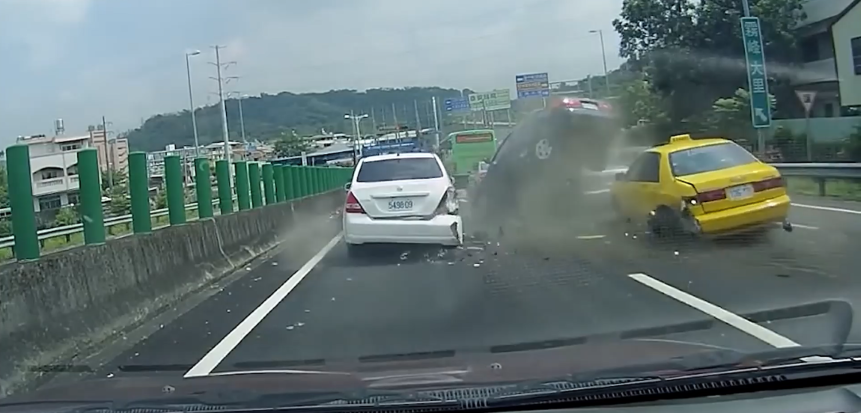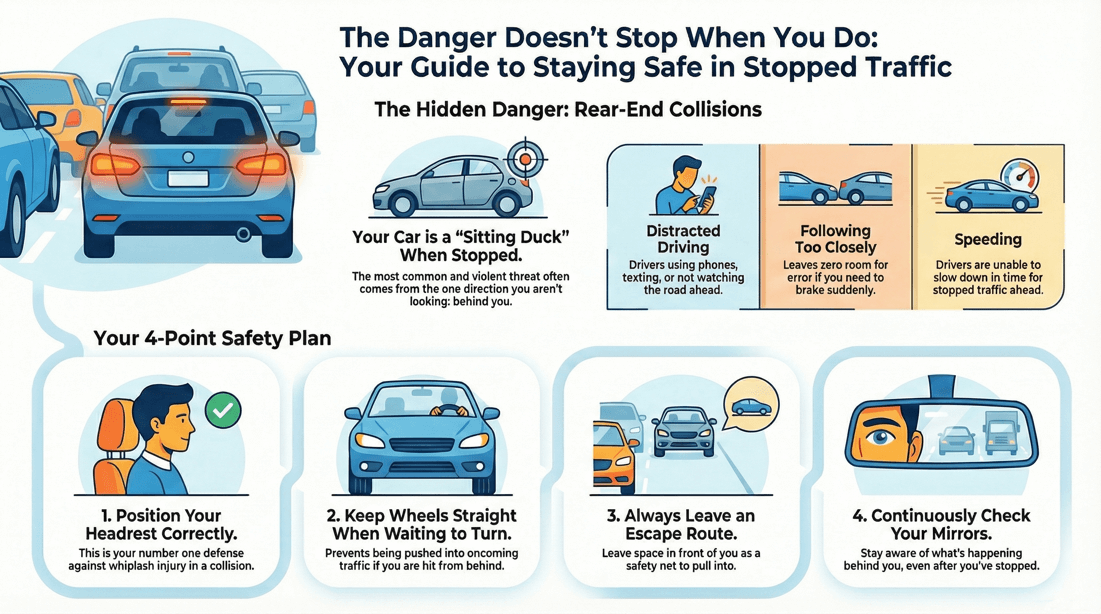
Stopped
☠️ Alert:
? Questions:
⮟ What happens when the vehicle in front of you comes to a sudden stop? ⮟ Are you prepared to react in time to avoid a rear-end collision? ⮟ How do you protect yourself from drivers who may not be paying attention behind you? ⮟ Why do so many drivers miss the signs that traffic is stopping? ⮟ What is the safest way to signal your intentions to drivers behind you?


☠️ Dangers when traffic has stopped
Rear-End Collisions:
Causes: Drivers approaching stopped traffic may not notice the situation in time, leading to rear-end collisions. This is often due to distraction, speeding, or following too closely. Consequences: Rear-end collisions can cause significant damage to vehicles and result in injuries, such as whiplash. Prevention: Maintain a Safe Following Distance: Keep a safe distance from the vehicle in front to allow time to stop. Be Alert: Stay focused on the road and be aware of traffic conditions ahead. Use Hazard Lights: In sudden stop situations, use hazard lights to alert drivers behind you.
Secondary Accidents:
Causes: Stopped traffic can lead to secondary accidents if drivers attempt to swerve, change lanes abruptly, or make other sudden maneuvers to avoid stopped vehicles. Consequences: These actions can result in collisions with other vehicles or cause chain-reaction accidents. Prevention: Signal Early: Use turn signals and brake lights to communicate your intentions clearly. Avoid Sudden Maneuvers: Slow down gradually and avoid abrupt changes in direction.
Pedestrian and Cyclist Risks:
Causes: In areas with stopped traffic, pedestrians and cyclists may navigate between vehicles, increasing the risk of accidents, especially if drivers are not expecting them. Consequences: Collisions with pedestrians and cyclists can result in serious injuries. Prevention: Be Vigilant: Look out for pedestrians and cyclists, especially near intersections and crosswalks. Yield to Pedestrians: Always yield to pedestrians and cyclists when they have the right-of-way.
Driver Distraction and Inattention:
Causes: Drivers may become distracted or inattentive when traffic is stopped, engaging in activities like using mobile phones, eating, or daydreaming. Consequences: Distraction can lead to delayed reactions and an increased risk of accidents. Prevention: Avoid Distractions: Stay focused on driving and avoid engaging in non-driving activities. Stay Engaged: Keep your mind on the road and be prepared to react to changing traffic conditions.
Road Rage and Aggressive Behavior:
Causes: Stopped traffic can lead to frustration, resulting in aggressive behaviors such as tailgating, honking, or confrontations with other drivers. Consequences: Road rage can escalate into dangerous situations, including aggressive driving, which increases the risk of accidents. Prevention: Stay Calm: Practice patience and manage your stress while driving. Avoid Confrontations: Do not engage with aggressive drivers; focus on maintaining your safety.
Visibility Issues:
Causes: Large vehicles or obstructed views can make it difficult to see what is happening ahead in stopped traffic. Consequences: Reduced visibility can lead to accidents, especially if drivers cannot see stopped vehicles or pedestrians ahead. Prevention: Maintain a Clear View: Position your vehicle to maintain a clear line of sight ahead whenever possible. Use Headlights: In low-visibility conditions, use your headlights to increase your visibility to others.
Emergency Situations:
Causes: Stopped traffic can result from emergencies, such as accidents or road closures, requiring drivers to react quickly and appropriately. Consequences: Failure to respond properly can lead to additional accidents or exacerbate the situation. Prevention: Stay Informed: Use traffic reports or navigation apps to stay updated on road conditions and emergencies. Follow Instructions: Obey traffic control measures and follow the directions of law enforcement or emergency personnel.
Mechanical Failures:
Causes: Stopped traffic, especially during long periods, can lead to overheating or other mechanical issues, particularly in hot weather. Consequences: Vehicle breakdowns can cause additional delays and potentially unsafe situations. Prevention: Monitor Vehicle Condition: Keep an eye on your vehicle's temperature gauge and other indicators. Perform Regular Maintenance: Ensure your vehicle is well-maintained and capable of handling traffic conditions.
? What are the most common causes of rear-end collisions?
Distracted Driving: Using phones, adjusting controls, or other distractions divert attention from the road Following Too Closely (Tailgating): Reduces reaction time to sudden stops ahead Speeding: Makes it harder to brake safely when traffic slows or stops unexpectedly Sudden Stops: Unexpected braking by the vehicle ahead can catch drivers off guard Poor Weather Conditions: Rain, fog, ice, and other factors reduce visibility and traction Driver Fatigue: Slower reaction times increase crash risk Mechanical Issues: Faulty brakes or worn tires can impair stopping ability
? What happens when the vehicle in front of you comes to a sudden stop?
Your reaction time is tested as you must quickly recognize the stop. You need to apply brakes promptly to avoid a collision bearing in mind any vehicles behind you. Under the circumstances it may be better to take an escape route even if you may be able to stop in time due to being rear ended. Maintaining a safe following distance gives you the space to stop safely. If you are distracted or following too closely, the risk of rear-ending increases. Sudden stops can cause a chain reaction, leading to multiple vehicle crashes. Proper vehicle maintenance, like good brakes and tires, helps ensure effective stopping. Defensive driving skills, such as scanning ahead and anticipating traffic changes, improve your response.
? Are you prepared to react in time to avoid a rear-end collision?
Stay fully focused on the road and avoid distractions. Maintain a safe following distance using the three-second rule. Continuously scan traffic ahead, not just the vehicle directly in front. Keep your brakes and tires well-maintained for reliable stopping power. Anticipate sudden stops by watching brake lights several vehicles ahead. Practice smooth and controlled braking to avoid abrupt stops. Be mentally prepared to respond quickly in unexpected situations.
? How do you protect yourself from drivers who may not be paying attention behind you?
Use your hazard lights to alert drivers when you slow down or stop unexpectedly. Maintain a safe distance from the vehicle ahead to allow room for sudden maneuvers. Avoid stopping in unsafe or unexpected locations whenever possible. If stopped, position your vehicle as far to the side as safely possible. Stay aware of traffic behind you and plan an escape route if needed. If you must exit your vehicle, stand well clear of traffic to avoid danger. Use your mirrors frequently to monitor vehicles approaching from behind.
? Why do so many drivers miss the signs that traffic is stopping?
Drivers are often distracted by phones, passengers, or other activities. Many drivers follow too closely, leaving little time to react. Fatigue slows reaction times and reduces awareness. Poor visibility due to weather or road conditions makes it harder to see brake lights. Some drivers fail to scan the road far enough ahead. Overconfidence or complacency leads to less cautious driving. Inexperienced drivers may not recognize subtle cues of slowing traffic.
? What is the safest way to signal your intentions to drivers behind you?
Activate your brake lights early by easing off the accelerator before braking. Use your turn signals well in advance of any lane changes or turns. If slowing suddenly or stopping unexpectedly, turn on your hazard lights promptly. Avoid abrupt or jerky movements that can confuse other drivers. Use hand signals if your vehicle’s lights are not functioning properly. Maintain consistent signaling so drivers can anticipate your next move. Check your mirrors to ensure drivers behind have noticed your signals.
? What should you do if your car stalls in traffic?
Stay calm and avoid sudden movements. Turn on your hazard lights immediately to alert drivers behind you. Attempt to restart the engine if it is safe to do so. If the car won’t start, carefully steer it to the side of the road or a safe location. Use your mirrors and check blind spots before moving the vehicle. Exit the vehicle only when it is safe, and stand well away from traffic. Call for roadside assistance or emergency help if needed.
? How can you prevent being rear-ended?
Maintain a steady speed and avoid sudden braking whenever possible. Keep a safe following distance from the vehicle ahead to allow smooth stops. Use your turn signals early to communicate lane changes or turns. Check mirrors frequently to be aware of vehicles behind you. Turn on hazard lights if you need to slow down or stop unexpectedly. Position your vehicle safely in the lane, avoiding abrupt movements. Stay alert and avoid distractions to anticipate traffic flow changes.
? Can traffic police stop you?
Reasons for Being Stopped
Traffic Violations : Speeding, running a red light, failing to stop at a stop sign, illegal turns, and other traffic infractions. Suspicion of Impaired Driving : If you are suspected of driving under the influence of alcohol or drugs. Equipment Violations : Issues with your vehicle such as broken headlights, taillights, or other safety-related equipment problems. Routine Checks : Random checks for valid driver's licenses, registration, insurance, and other legal requirements. Suspicious Behavior : If your driving behavior suggests you might be involved in illegal activities, such as erratic driving or attempting to evade police.
What to Do When Stopped
Pull Over Safely : Find a safe spot to pull over as soon as you can. Turn on your hazard lights to indicate you are complying. Stay Calm and Composed : Keep your hands visible, preferably on the steering wheel. Avoid making sudden movements. Follow Instructions : Listen to the officer’s instructions and comply with their requests, such as providing your driver's license, registration, and proof of insurance. Communicate Clearly : If you need to reach for something, inform the officer beforehand to avoid misunderstandings.
Your Rights
Right to Remain Silent : You have the right to remain silent. You can politely inform the officer that you choose to exercise this right. Right to Refuse Searches : Unless the officer has probable cause, you can refuse to consent to a vehicle search. However, if the officer has a warrant or believes there is probable cause, they may conduct a search without your consent. Right to Ask Why You Were Stopped : You can ask the officer for the reason for the stop. This can help you understand the situation better and ensure that the stop is justified.
Legal Recourse
Challenge in Court : If you believe the stop was unjustified or your rights were violated, you can challenge the stop and any resulting citations in court. File a Complaint : If you feel you were treated unfairly or unlawfully, you can file a complaint with the police department.
Conclusion
? How long do traffic stops last?
Nature of the Stop
Minor Violations : For common traffic violations like speeding or running a stop sign, a traffic stop may last about 10-15 minutes. The officer will usually check your documents, issue a warning or citation, and let you go. Serious Violations : If there is suspicion of impaired driving or criminal activity, the stop can last longer due to additional questioning, sobriety tests, or searches.
Document Check
License, Registration, and Insurance : The officer will check your driver's license, vehicle registration, and proof of insurance. If you have these documents readily available, this process is quick. Delays can occur if you need time to locate them or if there are issues with any of the documents.
Communication and Cooperation
Compliance : Cooperating and providing requested information promptly can shorten the stop. Arguments or non-compliance can extend the duration. Questions and Explanations : If the officer needs to explain the reason for the stop or if you have questions, this can add time.
Additional Checks
Warrants and Records : Officers often run a check for outstanding warrants or other issues related to your driving record, which can take additional time. Vehicle Search : If the officer has probable cause or you consent to a search, this can extend the duration of the stop.
Issuing Citations
Paperwork : Writing and explaining a citation or warning takes time. Some departments use electronic systems which can be faster, but it still requires a few minutes to process.
Situational Factors
Backup : If the officer calls for backup or needs assistance, this can lengthen the stop. Weather and Location : Adverse weather conditions or the location of the stop (e.g., a busy highway vs. a quiet street) can impact the time taken.
Average Duration
Typical Stops : Most routine traffic stops for minor violations are resolved within 10-20 minutes. Extended Stops : Stops involving more complex issues, such as DUI checks or vehicle searches, can take 30 minutes or more.
Conclusion
? Do traffic stops reduce crime?
Deterrence and Visibility
Increased Police Presence : Frequent traffic stops increase police visibility on the roads, which can act as a deterrent to criminal activity. Perception of Law Enforcement : Knowing that police are actively monitoring traffic can discourage both traffic violations and other types of crime.
Apprehension of Criminals
Detection of Wanted Individuals : Traffic stops can lead to the identification and apprehension of individuals with outstanding warrants or those involved in criminal activities. Discovery of Illegal Items : During traffic stops, police may find illegal drugs, weapons, or stolen property, leading to arrests and the prevention of further crimes.
Disruption of Criminal Activities
Impaired Drivers : Stopping and arresting impaired drivers prevents potential accidents and the possibility of those individuals committing other crimes. Suspicious Behavior : Traffic stops can interrupt and investigate suspicious behavior, potentially uncovering criminal plans or activities.
Gathering Intelligence
Information Gathering : Traffic stops can provide police with valuable information about individuals, vehicles, and patterns that may be linked to criminal activity. Community Interaction : Stops offer opportunities for officers to engage with the community, gather tips, and build trust, which can aid in crime prevention and solving.
Focus on High-Crime Areas
Targeted Patrols : Law enforcement can use traffic stops as a strategy in areas with high crime rates, focusing on times and locations with known criminal activity. Data-Driven Approaches : Utilizing data and analytics to guide traffic enforcement efforts can make traffic stops more effective in addressing crime.
Challenges and Considerations
Racial Profiling and Discrimination : There's a concern that traffic stops may disproportionately target minority communities, leading to issues of trust and potential civil rights violations. Resource Allocation : The effectiveness of traffic stops in reducing crime depends on proper resource allocation and ensuring that officers are trained to handle stops appropriately. Community Relations : Building positive relationships with the community is crucial. Over-reliance on traffic stops without considering community impact can erode trust in law enforcement.
Research and Evidence
Mixed Results : Studies have shown mixed results on the effectiveness of traffic stops in reducing crime. Some studies suggest that traffic stops can reduce certain types of crimes, while others indicate minimal impact. Holistic Approach : Traffic stops are most effective as part of a broader, multifaceted approach to crime prevention that includes community policing, data analysis, and targeted enforcement.
Conclusion
? Do traffic stops reduce accidents?
Deterrence of Dangerous Driving
Speeding : Regular traffic stops for speeding can deter drivers from exceeding speed limits, reducing the likelihood of accidents. Reckless Driving : Enforcing laws against reckless driving, such as aggressive lane changes and tailgating, can prevent accidents.
Enforcement of Traffic Laws
Impaired Driving : Traffic stops can identify and remove impaired drivers from the road, reducing the risk of accidents caused by drunk or drugged driving. Seat Belt Use : Enforcing seat belt laws through traffic stops can increase seat belt usage, reducing injury severity in accidents.
Public Awareness and Education
Awareness Campaigns : High-visibility enforcement campaigns, where traffic stops are combined with public awareness efforts, can educate drivers about the risks of unsafe driving behaviors. Behavioral Change : The experience of being stopped by police can prompt drivers to change their behavior, leading to safer driving practices.
Identification of Vehicle Safety Issues
Equipment Violations : Traffic stops can identify vehicles with safety issues, such as broken lights or worn tires, which can contribute to accidents if not addressed. Mandatory Inspections : Some traffic stops include vehicle inspections to ensure that cars meet safety standards.
Data Collection and Analysis
Accident Hotspots : Traffic stops can help law enforcement identify areas with high accident rates and target those areas for increased enforcement. Behavioral Trends : Data from traffic stops can reveal trends in driver behavior, allowing for more effective deployment of resources to prevent accidents.
Research and Evidence
Effectiveness : Studies have shown that targeted traffic enforcement can reduce the number of accidents, particularly in areas with high rates of traffic violations. Specific Measures : Programs like sobriety checkpoints and speed enforcement campaigns have been found to significantly decrease accident rates.
Challenges and Considerations
Resource Allocation : Effective traffic enforcement requires adequate resources, including trained personnel and equipment. Community Relations : Ensuring that traffic stops are conducted fairly and without bias is essential for maintaining public trust and cooperation. Balancing Enforcement and Education : Combining enforcement with educational efforts can enhance the effectiveness of traffic stops in reducing accidents.